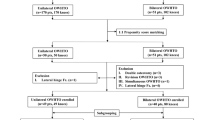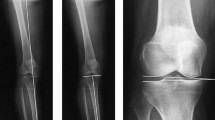Abstract
Purpose
There is a lack of studies investigating the distal tibial rotation (DTR) during medial opening wedge high tibial osteotomy (MOWHTO). This study was designed to evaluate osseous factors influencing DTR in patients who underwent biplane MOWHTO.
Methods
A total of 106 knee joints in 69 patients who underwent surgery for varus malalignment of knee were reviewed. Based on several software, standard and actual hinge positions were defined in pre-operative and post-operative CT data. Pearson’s correlation and Spearman’s correlation analysis were performed with DTR change as the dependent variable. Independent variables included angles between standard and actual hinge in the sagittal (ASAHS) and axial (ASAHA) planes, pre-operative and post-operative medial proximal tibial angle, opening width (OW), tuberosity osteotomy angle, flange angle (FA), gap ratio, and hinge fracture.
Results
The distal tibia rotated approximately 0.35° internally. Pearson’s and Spearman’s correlation analysis showed that DTR change was associated with ASAHS, OW, and FA. Larger OW and FA resulted in higher external rotation angles.
Conclusions
DTR change was significantly associated with ASAHS, followed by OW and FA rather than ASAHA if only considering osseous factors in biplane MOWHTO. The distal tibia tended to rotate externally when the actual hinge was inclined posteriorly to the standard hinge in the sagittal planes, but rotate externally or internally when the actual hinge was inclined anteriorly.





Similar content being viewed by others
Data availability
The data are available from the corresponding author on reasonable request.
References
Belsey J, Yasen SK, Jobson S, Faulkner J, Wilson AJ (2021) Return to physical activity after high tibial osteotomy or unicompartmental knee arthroplasty: a systematic review and pooling data analysis. Am J Sports Med 49(5):1372–1380. https://doi.org/10.1177/0363546520948861
Ollivier B, Berger P, Depuydt C, Vandenneucker H (2021) Good long-term survival and patient-reported outcomes after high tibial osteotomy for medial compartment osteoarthritis. Knee Surg Sports Traumatol Arthrosc 29(11):3569–3584. https://doi.org/10.1007/s00167-020-06262-4
Eliasberg CD, Hancock KJ, Swartwout E, Robichaud H, Ranawat AS (2021) The ideal hinge axis position to reduce tibial slope in opening-wedge high tibial osteotomy includes proximalization-extension and internal rotation. Arthroscopy 37(5):1577–1584. https://doi.org/10.1016/j.arthro.2020.12.203
Chung JH, Choi CH, Kim SH, Kim SJ, Lee SK, Jung M (2021) Effect of the osteotomy inclination angle in the sagittal plane on the posterior tibial slope of the tibiofemoral joint in medial open-wedge high tibial osteotomy: three-dimensional computed tomography analysis. J Clin Med 10(18). https://doi.org/10.3390/jcm10184272
Kim JI, Kim BH, Han HS, Lee MC (2020) Rotational changes in the tibia after high tibial valgus osteotomy: a comparative study of lateral closing versus medial opening wedge osteotomy. Am J Sports Med 48(14):3549–3556. https://doi.org/10.1177/0363546520960114
Jang KM, Lee JH, Park HJ, Kim JL, Han SB (2016) Unintended rotational changes of the distal tibia after biplane medial open-wedge high tibial osteotomy. J Arthroplast 31(1):59–63. https://doi.org/10.1016/j.arth.2015.08.010
Jacobi M, Villa V, Reischl N, Demey G, Goy D, Neyret P et al (2015) Factors influencing posterior tibial slope and tibial rotation in opening wedge high tibial osteotomy. Knee Surg Sports Traumatol Arthrosc 23(9):2762–2768. https://doi.org/10.1007/s00167-014-3100-8
Kendoff D, Lo D, Goleski P, Warkentine B, O'Loughlin PF, Pearle AD (2008) Open wedge tibial osteotomies influence on axial rotation and tibial slope. Knee Surg Sports Traumatol Arthrosc 16(10):904–910. https://doi.org/10.1007/s00167-008-0567-1
Teng Y, Mizu-Uchi H, **a Y, Akasaki Y, Akiyama T, Kawahara S et al (2021) Axial but not sagittal hinge axis affects posterior tibial slope in medial open-wedge high tibial osteotomy: a 3-dimensional surgical simulation study. Arthroscopy 37(7):2191–2201. https://doi.org/10.1016/j.arthro.2021.01.063
Wang JH, Bae JH, Lim HC, Shon WY, Kim CW, Cho JW (2009) Medial open wedge high tibial osteotomy: the effect of the cortical hinge on posterior tibial slope. Am J Sports Med 37(12):2411–2418. https://doi.org/10.1177/0363546509341174
Chang SS, Lin SC, Chan YS, Wu CT, Hsu KY, Chen CM et al (2021) How do lateral hinge and distraction affect three-dimensional rotation in open wedge high tibial osteotomy? J Orthop Sci 26(6):1056–1063. https://doi.org/10.1016/j.jos.2020.10.006
Kim JH, Kim HY, Lee DH (2020) Opening gap width influences distal tibial rotation below the osteotomy site following open wedge high tibial osteotomy. PLoS One 15(1):e227969. https://doi.org/10.1371/journal.pone.0227969
Sasaki T, Akamatsu Y, Kobayashi H, Mitsuhashi S, Nejima S, Kumagai K et al (2021) Rotational changes in the distal tibial fragment relative to the proximal tibial fragment at the osteotomy site after open-wedge high-tibial osteotomy. Biomed Res Int 2021:6357109. https://doi.org/10.1155/2021/6357109
Lee BH, Ha CW, Moon SW, Chang M, Kim HY, Park SH et al (2017) Three-dimensional relationships between secondary changes and selective osteotomy parameters for biplane medial open-wedge high tibial osteotomy. Knee 24(2):362–371. https://doi.org/10.1016/j.knee.2016.11.010
Suero EM, Hawi N, Westphal R, Sabbagh Y, Citak M, Wahl FM et al (2017) The effect of distal tibial rotation during high tibial osteotomy on the contact pressures in the knee and ankle joints. Knee Surg Sports Traumatol Arthrosc 25(1):299–305. https://doi.org/10.1007/s00167-015-3553-4
Kim JG, Suh DH, Choi GW, Koo BM, Kim SG (2021) Change in the weight-bearing line ratio of the ankle joint and ankle joint line orientation after knee arthroplasty and high tibial osteotomy in patients with genu varum deformity. Int Orthop 45(1):117–124. https://doi.org/10.1007/s00264-020-04799-0
Akagi M, Oh M, Nonaka T, Tsujimoto H, Asano T, Hamanishi C (2004) An anteroposterior axis of the tibia for total knee arthroplasty. Clin Orthop Relat Res (420):213–219. https://doi.org/10.1097/00003086-200403000-00030
Hinterwimmer S, Feucht MJ, Paul J, Kirchhoff C, Sauerschnig M, Imhoff AB et al (2016) Analysis of the effects of high tibial osteotomy on tibial rotation. Int Orthop 40(9):1849–1854. https://doi.org/10.1007/s00264-015-3100-4
Kuwashima U, Takeuchi R, Ishikawa H, Shioda M, Nakashima Y, Schroter S (2019) Comparison of torsional changes in the tibia following a lateral closed or medial open wedge high tibial osteotomy. Knee 26(2):374–381. https://doi.org/10.1016/j.knee.2019.01.009
Kaya H, Dastan AE, Bicer EK, Taskiran E (2020) Posteromedial open-wedge high tibial osteotomy to avoid posterior tibial slope increase. Arthroscopy 36(10):2710–2717. https://doi.org/10.1016/j.arthro.2020.06.024
Tseng TH, Tsai YC, Lin KY, Kuo YK, Wang JH (2019) The correlation of sagittal osteotomy inclination and the anteroposterior translation in medial open-wedge high tibial osteotomy-one of the causes affecting the patellofemoral joint? Int Orthop 43(3):605–610. https://doi.org/10.1007/s00264-018-3951-6
Lee SY, Lim HC, Bae JH, Kim JG, Yun SH, Yang JH et al (2017) Sagittal osteotomy inclination in medial open-wedge high tibial osteotomy. Knee Surg Sports Traumatol Arthrosc 25(3):823–831. https://doi.org/10.1007/s00167-016-4115-0
Funding
This work was supported by grants from China Research and Promotion of Traditional Chinese Medicine (2021-18) and grants from the Traditional Chinese Medicine Technology of Shandong Province (2021M173).
Author information
Authors and Affiliations
Contributions
LZJ contributed to the literature search, data analysis, and manuscript preparation. WGW contributed to data collection. LY contributed to statistics analysis and manuscript editing. XZ contributed to the data collection and analysis. JSY contributed to the conceptualization and manuscript review. JW contributed to the substantial conceptualization, supervision, and final approval of the draft version. All authors read and approved the final manuscript.
Corresponding authors
Ethics declarations
Ethics approval
This study was approved by the Board of Research Ethics of our hospital (2021-059-KY).
Informed consent
Every patient signed informed consent in this study.
Conflict of interest
The authors declare no competing interests.
Additional information
Publisher’s note
Springer Nature remains neutral with regard to jurisdictional claims in published maps and institutional affiliations.
Rights and permissions
Springer Nature or its licensor (e.g. a society or other partner) holds exclusive rights to this article under a publishing agreement with the author(s) or other rightsholder(s); author self-archiving of the accepted manuscript version of this article is solely governed by the terms of such publishing agreement and applicable law.
About this article
Cite this article
**g, L., Zhao, X., Wang, W. et al. Osseous factors influencing distal tibial rotation in biplane medial opening wedge high tibial osteotomy. International Orthopaedics (SICOT) 48, 465–471 (2024). https://doi.org/10.1007/s00264-023-05968-7
Received:
Accepted:
Published:
Issue Date:
DOI: https://doi.org/10.1007/s00264-023-05968-7




